6 times Malaysians lost their chill over statues

- 1.5KShares
- Facebook1.4K
- Twitter16
- LinkedIn21
- Email29
- WhatsApp62
This recently happened in the US: Confederate statues are being taken down across the states, following an incident in Charlottesville, a university town in Virginia, USA. A protest against racism and fascism turned ugly after a car rammed into a crowd of protesters, killing a woman and injuring several others.

This incident added to the effects of another event that happened back in 2015, where a white man killed nine African-American parishioners in a church in South Carolina, days after the 150th anniversary of the American Civil War. Photos of him posing with Confederate flags changed how people now view the Confederate symbols, and the recent incident in Charlottesville was believed to have sparked a wave of Confederate statue removals.
While defenders of the Confederate statues say that they were not meant to symbolize slavery (the Civil War happened due to the Southern states protesting against anti-slave laws by the north), a BBC article had stated that most historians agreed that the statues were indeed about slavery, and that racial minorities, particularly African-Americans, feel that the statues’ presence in public was offensive.

On the other hand, Indonesia had earlier this month urged its officials to not bow down to pressure from the Muslim and nationalist protesters to destroy a 30-meter-tall statue of Guan Yu, a former Chinese war general who was worshipped by some Chinese. The gigantic statue, housed in a temple complex in Tuban, had to be covered with an equally gigantic white sheet for the time being to pacify infuriated protesters in the Muslim-majority nation.
By now you might be thinking, why are all these people getting so worked up over statues? We’ll answer that in a moment, but first, here are 6 examples when Malaysians lost their chill because of statues.
1) When people tried to tear down a tourism icon
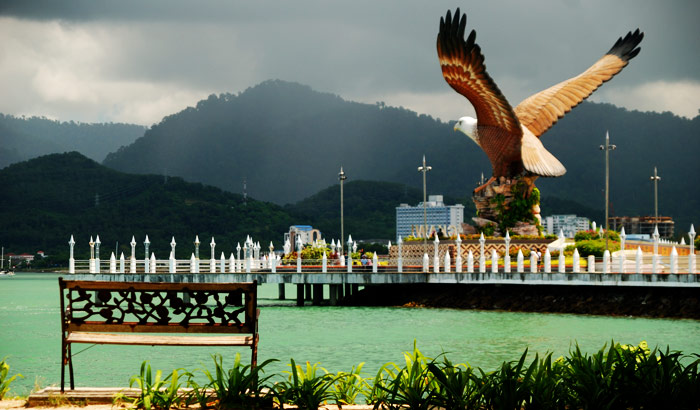
The statue:
The Eagle of Langkawi, a 12-meter statue of a reddish-brown eagle at the Eagle Square (Dataran Helang) in Kuah, Langkawi. Some sources say that the statue was inspired by one of the origin stories of Langkawi’s name, which is a portmanteau of ‘Lang’, a shortened form of ‘helang’ (eagle), and ‘kawi’, a reddish stone used as a chalk to mark goods in olden times. This sculpture was built sometime in the 1990s and costs around RM1.3 million.
The controversy:
Last year, Zamri Hashim, Perak’s deputy mufti wrote a column in Berita Harian that answers a question from a local authority supposedly asking about whether it’s okay to build a replica of an eagle for a place known for its eagles. It was never disclosed which local authority that was, but Zamri had wrote that
“The consensus from all scholars from all sects of Ahli Sunnah wal Jamaah puts forth that it is haram to build or make replicas and statues that are complete for living creatures such as humans or animals. What’s more, if it had already been built, it’s compulsory to tear it down, while building or making one is a huge sin,” – Zamri Hashim, Deputy mufti of Perak, translated from MalaysiaKini.
The Ipoh chief of Ikatan Muslimin Malaysia (Isma), an Islamic group, had seconded the demolishing part of Zamri’s article. Even Tan Sri Harussani Zakaria, the Perak mufti himself, had defended his deputy’s statement on the matter. Harussani, however, refused to comment when asked if a tourism icon like the one found in Langkawi should be demolished, just stating that the thing to understand here is that what’s forbidden will remain forbidden.
The outcome:
Langkawi’s Tourism Association (LTA) had since protested any proposals to demolish the statue, saying that the statue had attracted thousands of tourists for the past two decades. In an interview with Bernama, Zainuddin Kadir, the president of LTA, had stressed that the eagle statue was Langkawi’s icon and have never been a place of worship or a place where anti-religious activities were performed.
Zamri Hashim, through Ismaweb, had later expressed his regret and disappointment on how his statement on the issue had been twisted by liberal media.
“I did not touch on the issue of demolishing the eagle monument in Langkawi as it is under the purview of each state’s authority. What I did touch on, however, was a local issue in Perak, which had nothing to do with the either the eagle replica in Langkawi or the National Monument,” – Zamri Hashim, as reported by Ismaweb.
2) When a theme park had to redecorate
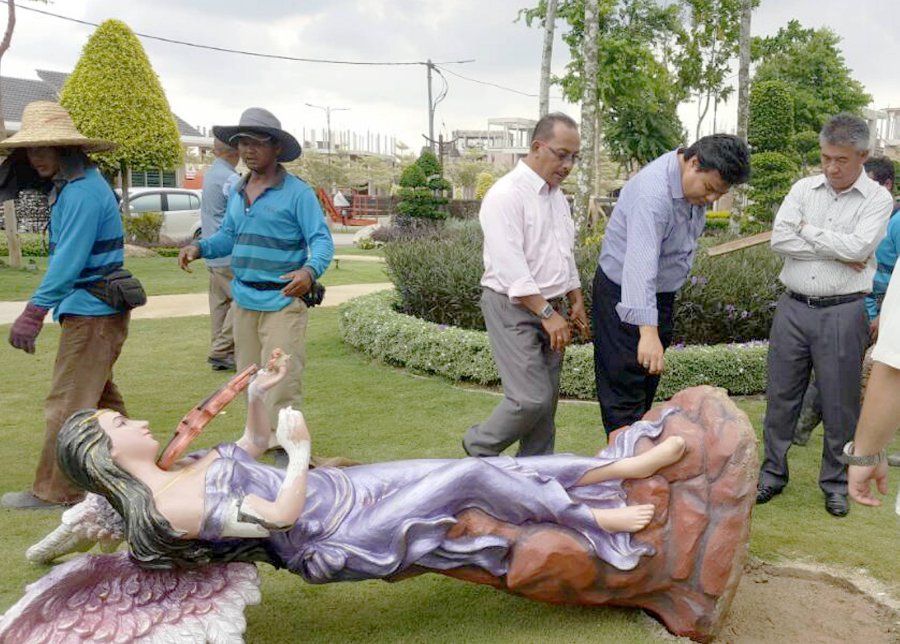
The statues:
Two statues of winged women from Taman MBI Desaku in Padang Meha, Kulim, Kedah. There are five landscape themes set up in the park, featuring statues meant to represent Disneyland, Japan, Cactus, Holland and Bali, and the statues in question were from the Bali landscape.
The Controversy:
Following complaints by some netizens who felt uncomfortable with the display of ‘god-like’ figures in the park, the Kulim district office ordered for the park’s closure and the removal of two statues resembling winged women from the park. Another source had stated that the complaints came from the local residents, who also felt uncomfortable for the same reason.
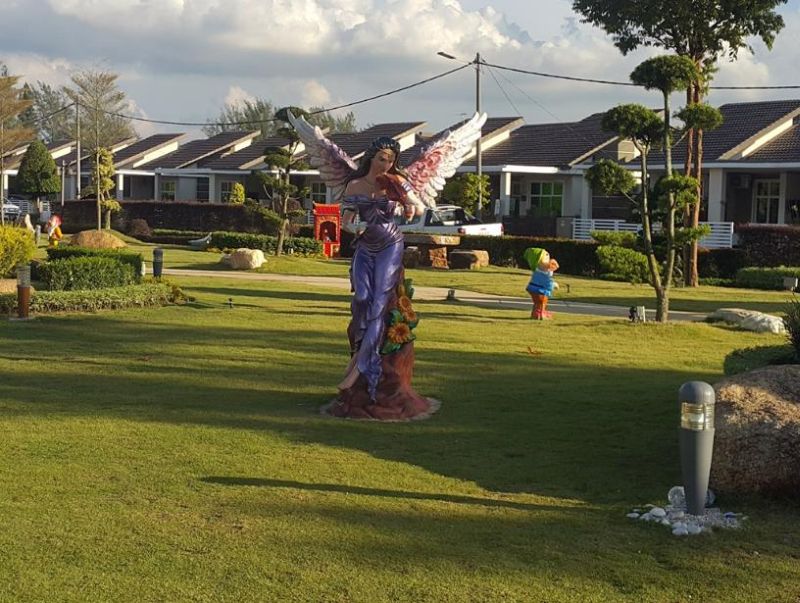
Following a meeting with the park’s management, the district office of Kulim had ordered for the removal of another 20 statues from the park as they were deemed inappropriate. The developers were also instructed to come up with a written list of the current statues in the park as well as new statues that they plan to build in the future and submit it to the state mufti for consideration.
The Outcome:
While the park’s management seemed OK with the district office ordering them to remove some 20 statues from their park by the end of September, others have found the whole thing ridiculous. Azhar Harun, a lawyer-activist observed that developers are not required to get any approval from muftis or ulamas, or even a state’s religious authority as long as they have a business license and a permit for a theme park.
“There seems to be a terrible confusion between religious beliefs and administration of the state here,” – Azhar Harun, for FMT.
Azhar had further stated that the solution of not being happy with the statues is simply to just not go there, especially if you have to buy a ticket to get inside.
3) When a 1Malaysia sculpture was protested
The statue:

The controversy:
Monuments in the shape of Najib’s 1Malaysia logo is apparently haram, according Perlis’ Fatwa Council. Back in 2011, a fatwa was released by the council that declares it forbidden to build 1Malaysia monuments as it has elements of respect that may lead to idolatry. The notion was said to be based on the Quran chapter al-Maidah, 90, which said:
“O you who have believed, indeed, intoxicants, gambling, [sacrificing on] stone alters [to other than Allah ], and divining arrows are but defilement from the work of Satan, so avoid it that you may be successful.” – Al-Maidah, 90.
This fatwa was also based on a prevention method that preserves one’s conviction (Sadd al-Zara’i), citing an instance where Prophet Muhammad (pbuh) forbade his followers to make a tree called the Zat Anwath as a meeting place, as quoted by al-Tarmizi. Also, it might have something to do with wasting resources, which is also haram in Islam.
The Outcome:
The fatwa was decided during a council meeting, and was consented to by the Raja of Perlis. However, the Perlis Mufti had said that the fatwa will not be gazetted, meaning that it’s more of an advice rather than an outright law for Muslims.

While formal news on the issue was limited, some blogs have published what seemed to be copies of news regarding it, like this one where the Dewan Ulama PAS of Perlis allegedly sees the failure of committing to the fatwa as an insult to the Raja of Perlis, who is also the religious leader of Perlis.
“Even though there are government premises such as the Perlis State Assembly Complex that had taken down the statue, there are still places that have not. The Dewan Ulama Perlis feels disappointed with these parties who ignored this fatwa. They’re not only going against the fatwa, but are also insulting His Majesty as religious matters are under his purview,” – Ustaz Saleh Adam, deputy chief of Dewan Ulama Perlis, as quoted by PeghelihLa.
4) When a teapot cult was torn down
The statues:
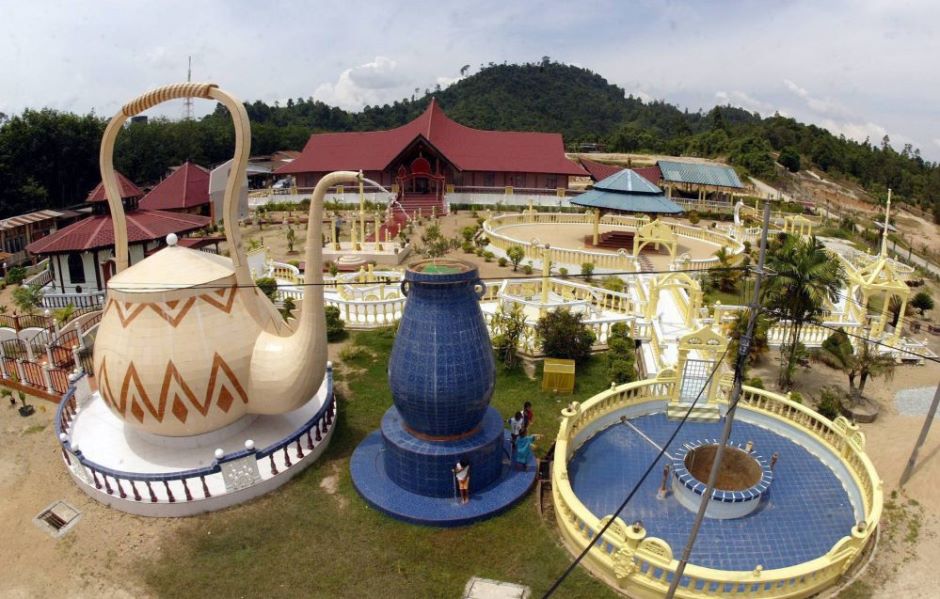
Statues from the now gone Sky Kingdom of Ayah Pin, which include a two-storey high cream colored teapot that symbolizes the purity of water and love pouring from heaven; a slightly smaller blue vase filled with holy water from the teapot; a large yellow umbrella for the people to ‘take shelter beneath God’; as well as other symbols such as a fishing boat replica and a crescent moon.
The controversy:
The Kerajaan Langit, or Sky Kingdom, was a cult founded by a guy named Ariffin Mohammed in Besut, Terengganu. Ariffin, or more famously known as Ayah Pin, believed himself to have contact with the heavens, and his followers believed him to be the reincarnation of Jesus, Buddha, Shiva and Muhammad. His followers came from various faiths: a major emphasis in the Sky Kingdom was inter-religious harmony and discussions to bring the different faiths closer.
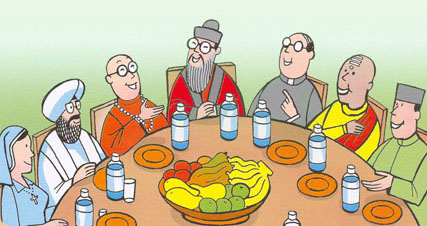
It all went well until 1997, when the Terengganu government sniffed out the sect and promptly issued a fatwa that banned people from associating with Ayah Pin. The Sky Kingdom was later labelled as a heretical sect, and it was attacked by vigilantes wearing Arab robes and wielding Molotov cocktails. Following raids by the authorities and attacks by people, Ayah Pin slipped across the border into Thailand, and passed away last year in his home in Terengganu.
The outcome:
Everything in Sky Kingdom was bulldozed clean. While Ayah Pin was known for teaching some questionable stuff in his time, the crackdown on his cult had some people and organizations questioning whether Malaysia really allows for freedom of religion or not.
5) When the existence of a monument honoring veterans was questioned
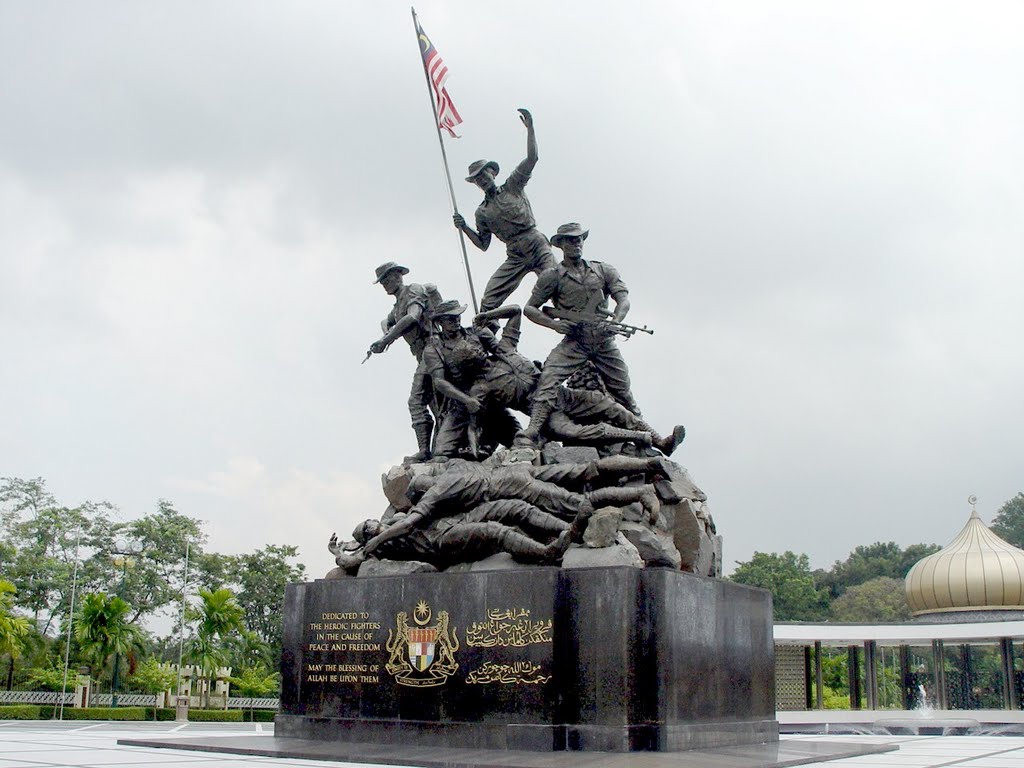
The statue:
The Tugu Negara, or the National Monument.
The Controversy:
In September last year, Harussani Zakaria, the Perak Mufti, was reported to have said that it is a big sin to build monuments in the likeness of humans, and therefore the Tugu Negara could be considered as haram in Islam. He had further stated that this is because in the afterlife, God would ask the creators to give life to their creations.

Another issue with the Tugu Negara, according to Harussani, was that holding ceremonies like the Hari Pahlawan celebrations there bordered on idolatry.
“From the beginning, we did not agree (with Tugu Negara) as we are an Islamic country. Why are we worshiping monuments?” – Harussani Zakaria, as quoted by FMT.
The comments from Harussani probably came from Prime Minister Najib Razak’s announcement of plans to develop a 66-acre park around the Tugu Negara. The RM650 million estimated for the project, according to Harussani, is a waste of taxpayer’s money and should be instead used for the people, like building houses for the poor.
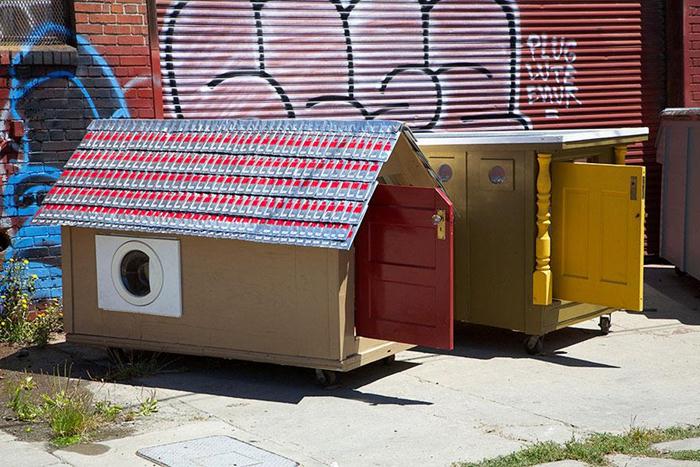
This wasn’t the first time the Tugu Negara’s existence was questioned. Back in 2008, the Perlis mufti, Dr Mohd Asri Zainul Abidin had stated that Malaysia did not need a National Monument as on top of it ‘not being our tradition‘, it has ‘elements of idolatry‘ as well. In his blog, Asri had also advised for people who participated in placing wreaths at the monument during 2008’s Hari Pahlawan to repent and return to Islam.
The Outcome:
Hari Pahlawan had changed since 2010. Due to JAKIM as well as the National Fatwa Council setting forth guidelines that Hari Pahlawan celebrations could not be held at a place with human statues, the venue for Hari Pahlawan had shifted to Dataran Merdeka. The National Fatwa Council had also set some guidelines on previous events on Hari Pahlawan, so things like blowing the Last Post and the Rouse, having a moment of silence, laying wreaths, reading poems, and singing are all not allowed in front of the Tugu Negara.
6) When a supposed plan to build a Kuan Yin statue was protested
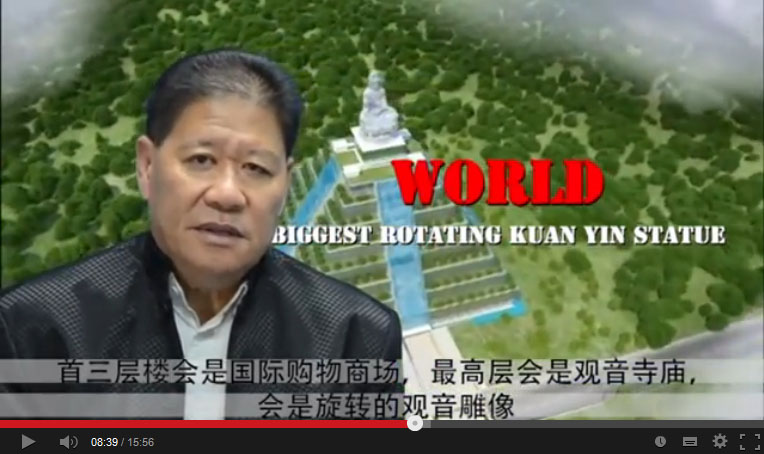
The statue:
A Kuan Yin statue planned to be the biggest in the world, standing atop a 30-storey pyramid (also the biggest in the world) which is also a columbarium (a place to store ashes, also the biggest in the world). The statue was supposed to be part of a project called the 1 Malaysia Spiritual Tourism Park (1MST), covering a 500-acre piece of land in Pahang. Enchant Acres Sdn Bhd, the company behind this project had stated that the park aimed to showcase religions like Buddhism, Christianity, Sikhism, Taoism, I-Kuan Tao, Sai Baba and Hinduism, to name a few.
The Controversy:
During this 2013 controversy, Abdullah Zaik Abd Rahman, the president of Ikatan Muslimin Malaysia (ISMA) had stated that the 1MST aimed to challenge the position of Islam as the religion of the Federation. Speaking to the Malay Mail Online, Abdullah had expressed his concerns that the image of Malaysia as a Muslim country will fade once the other religions are highlighted for tourism purposes.
“Besides that, Malaysia will be known as a country that can unite all religions except Islam. This mega project will be the symbol of inter-religious cooperation and unity. The image of Islam will be destroyed. This should not happen,” – Abdullah Zaik, as reported by the Malay Mail Online.
There’s more to the story. The Enchant Acres website had stated that the 1MST project was fully supported by Putrajaya, however no government official had admitted that they knew anything about it. Datuk Seri Mohamed Nazri Aziz, the Tourism Minister himself, was reported to know nothing about the 1MSTR. The same goes for Pahang’s tourism authorities. Both members of the state’s branch of Tourism Malaysia as well as the state’s tourism office insisted that they had not heard of it.
Pahang’s Menteri Besar, Datuk Seri Adnan Yaakob had denied approving any land for the purposes of 1MST, saying that it was never discussed by the exco, and will never be built in Pahang.
The Outcome:
As it turned out, Enchant Acres had offered five million columbarium niches to the public at RM12,000 each. On its website, Enchant Acres had allegedly published a marketing plan following a multi-tiered business model that promises people who book these niches a huge return if they resell them to the company. There’s also three tiers of membership, where benefits and promised compensation increase based on the tiers.

Commissions can also be gained if an investor managed to sell bookings for niches to other people, either personally or through a sales group. This would make them eligible to earn bonuses from something called the ‘Orchid World Pool‘ that could contain up to RM196 million.
Following the revelation that the authorities know nothing about this project, seven buyers lodged police reports saying that they have been tricked into buying columbarium niches. The developer had since claimed that their project is ‘above board’. While the video claimed that the 1MST was supposed to be completed by 2016, it seemed that it never took off after all.
So why are people so affected by lumps of metal and stone?
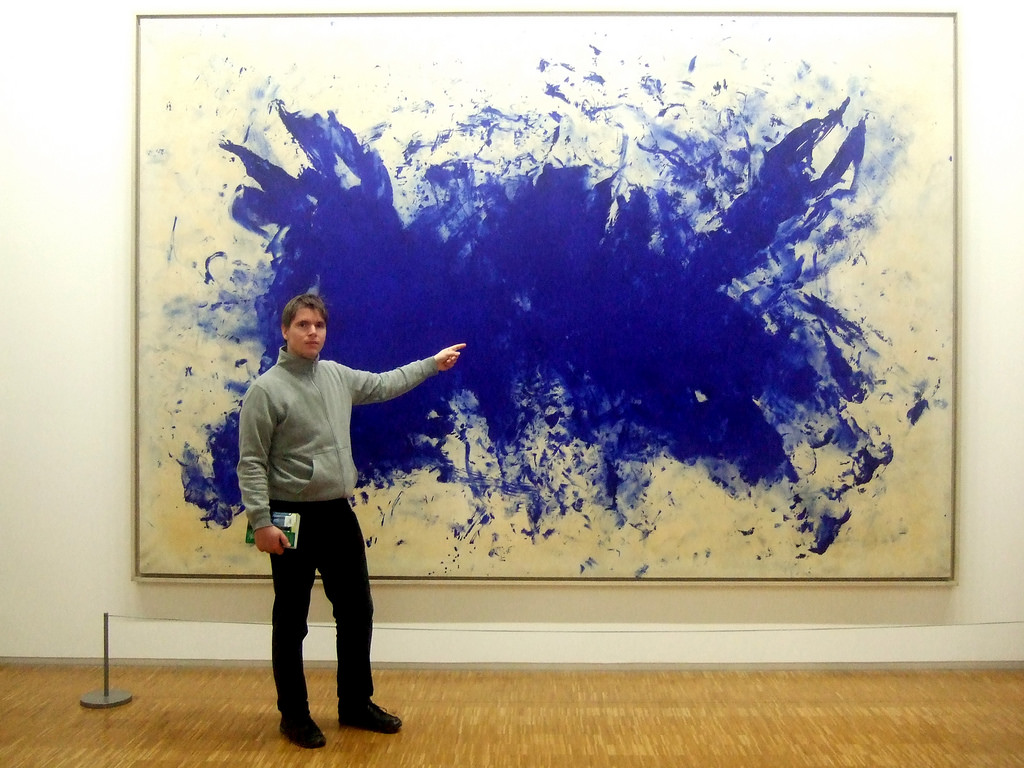
Remember learning Sonnet 18 by William Shakespeare back in school? The one that begins with “Shall I compare thee to a summer’s day?” While our curriculum provides a set of interpretations for us to remember, perhaps none of our teachers mentioned that some scholars interpret the sonnet to have had something to do with homosexual love.
While it may sound unrelated, sonnets, poems, paintings and sculptures can be broadly classified as works of art, and as is the case with art, the meaning is almost never literal, up to the interpretation of the beholder. Such is the case with statues. In the case of the Guan Yu statue in Indonesia, some may see the stature of the statue as befitting a deity called Saint of War, while some may see the size of the statue as an attempt to belittle their own deity.
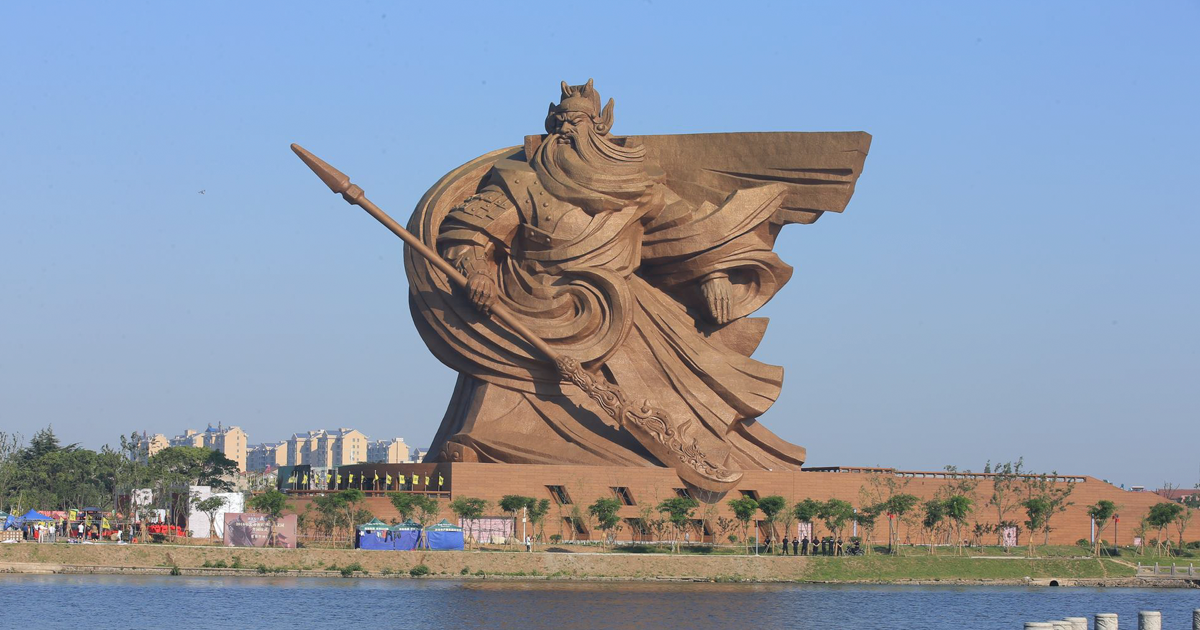
As for Malaysia, where most of the cases in this article had something to do with idolatry, Dr Mahathir believed that modern Muslims know that some statues, such as the one in Langkawi, is not a god to be worshiped, and destroying it won’t make the Malays more Muslim in any way.
“Modern Muslims know that these are not gods and they don’t worship them… the day some Muslims place joss-sticks and genuflect before the Eagle in Langkawi, that day the offending Muslim should be told that they are not following the injunctions of Islam,” – Dr Mahathir, for the Malay Mail Online.
Professor Tajuddin Rasdi, an academic who teaches architecture with an emphasis on Islamic architecture at the UCSI, had stated that the prohibition on statues and monuments was a recent practice in the Islamic world. This was proved by the existing artworks that remained in countries once colonized by the Islamic Empire, like Qasr Al-Msahtta, a castle in Jordan that still had animal sculptures on some of it walls after more than a millennium.
Tajuddin had stressed on the importance of visual art as a means of communication for the purposes of documentation and learning.
“We need to look back at history. How were things documented in the past? There were paintings that depict how Malays used to dress in the past. If (visual arts) like these were forbidden, we’d have no way of knowing all that,” – Professor Tajuddin Rasdi, for FMT.
- 1.5KShares
- Facebook1.4K
- Twitter16
- LinkedIn21
- Email29
- WhatsApp62



